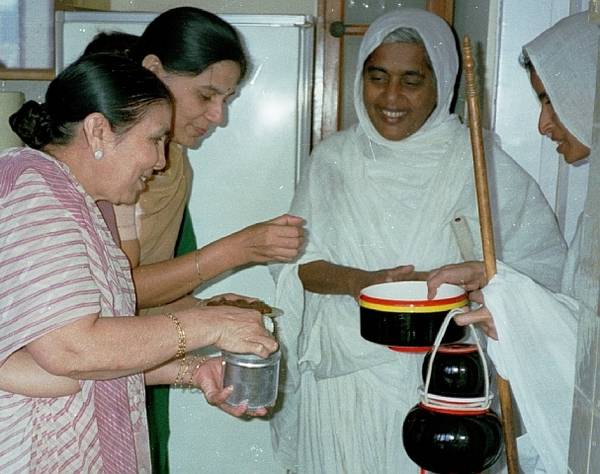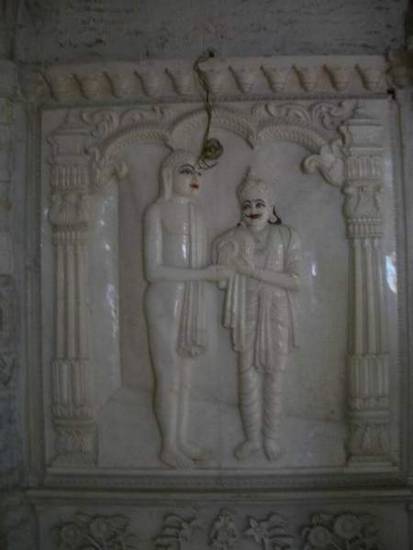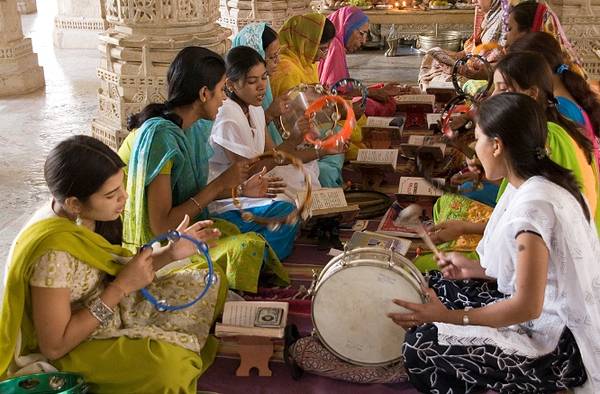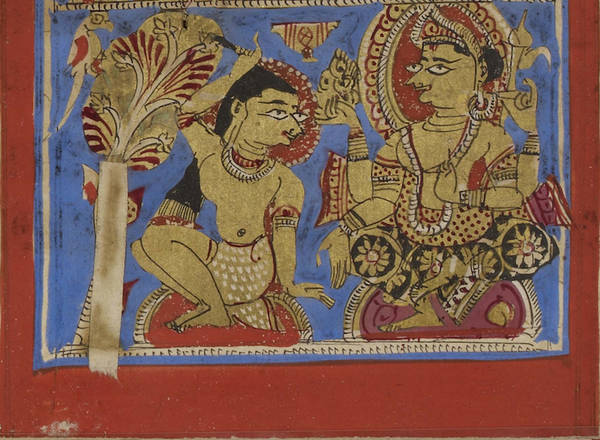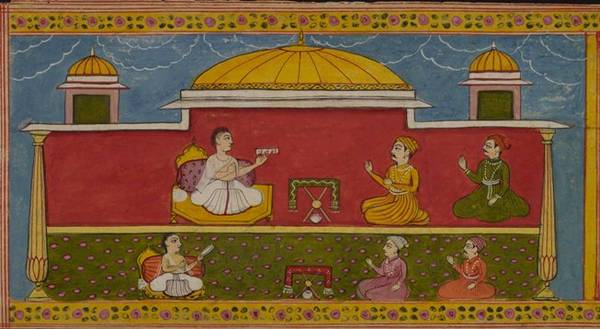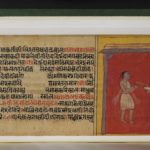Article: Akṣaya-tṛtīyā
Known as Akṣaya-tṛtīyā in Sanskrit or by its modern form Akhātrīj, the ‘Immortal Third’ is a date common to both Jains and Hindus. It falls on the third day of the bright half of Vaiśākha, equivalent to mid-April to mid-May in the Western calendar. For the Jains, it commemorates the first proper alms-giving to a Jain monk through the example of the first Jina, Ṛṣabhanātha or Lord Ṛṣabha, and is celebrated by both major sects of Śvetāmbaras and Digambaras.
The culmination of the year-long fast known as varṣītap, Akṣaya-tṛtīyā features a fast-breaking ceremony at a temple dedicated to Ṛṣabha. The fasters are ritually fed by relatives in a public ceremony and are generally feted for their religious devotion and the physical and mental feat of such a long fast.
As well as the standard festival activities of listening to sermons and attending temple, pilgrimages to sites associated with Ṛṣabha’s fast-breaking, such as Hastinapur and Mount Shatrunjaya, have become increasingly popular in recent decades.
Concept of giving alms
Among the 24 Jinas of the current descending cycle of time known as avasarpiṇī, the first Jina Ṛṣabhanātha or Lord Ṛṣabha has a special place. Before him it was a golden age where people got everything they needed from wishing-trees and did not need to work. There was thus no need for agriculture or skills such as weaving. There were also no social institutions, such as marriage, because people lived in couples of male and female twins. Ṛṣabha is credited with organising society and inventing elements necessary for human civilisation, such as reading, writing, mathematics and farming.
The key event behind the Akṣaya-tṛtīyā festival is told in accounts of the first Jina’s life. The correct offering of alms to Ṛṣabha ended his 13-month fast and thus the festival underlines the importance of offering and receiving alms in the proper way.
The first tales of Ṛṣabha’s receiving alms date back to the first centuries of the Common Era. One of the earliest is the Āvaśyaka-niryukti, an encyclopaedic verse commentary. At the time of Ṛṣabha’s ‘excellent and dreadful resolution’ to go from one village to another, inaugurating the vihāra tradition, and take a vow of silence, people did not know ‘which type of alms is to be given, of what sort [of people] wandering mendicants are’. Nevertheless, perfectly peaceful in his mind, the Jina-to-be wandered for one year without food. It is not that he was never invited. On the contrary, as the text says: ‘he is invited by young girls, with [offers of] clothes, ornaments and seats’.
The Vasudeva-hiṇḍī, a Prakrit narrative from the same period, broadly agrees that Ṛṣabha refused many offers of alms. The implication is that all these splendid proposals are useless because they are not suitable for the First Lord. Later accounts greatly amplify this part by describing the sadness and surprise of the donors whose gifts are refused.
Prince Śreyāṃsa and Ṛṣabha
The monk Ṛṣabhanātha or Lord Ṛṣabha had refused all alms for a year when his wanderings took him to the town of Hastināpura, called Hastinapur in common parlance, where Prince Śreyāṃsa lived. One night the prince dreamed of his previous births and thus recalled what to give as alms to a wandering ascetic. The next day Śreyāṃsa offered Ṛṣabha sugar-cane juice and the monk was finally able to break his fast – pāraṇā. The prince was rewarded with the five marvellous gifts one normally gets on such an occasion.
This episode is part of the cosmogonical myth that forms a major element of Ṛṣabha’s life story. Śreyāṃsa is considered the founder of alms-giving: ‘He is the donor of alms to the first Jina in the avasarpiṇī‘, as the Vasudeva puts it. In the 12th century, Hemacandra, the author of the standard Śvetāmbara biographies of the Jinas, states this clearly:
Beginning with Śreyāṃsa[,] the duty of giving originated on earth, just as the course of all practices and laws [originated] with the Master [= Ṛṣabha].
Trīṣaṣṭiśalākapuruṣacaritra
translation by Johnson, volume I, page 181
Śreyāṃsa as the first alms donor and Ṛṣabha as the first monk and future Jina receiving them provide the pattern for giving and receiving alms. The ritual of alms-giving is a cornerstone of the relationships of the fourfold community and hence vital for the survival of the Jain faith.
Depictions of Śreyāṃsa and Ṛṣabha are occasionally found in paintings in manuscripts of the Kalpa-sūtra. The text itself does not mention the episode, but the commentaries narrate it at length and it has become part of the narrative and pictorial tradition (Norman Brown 1934: plate 37, figure 125; also in Jain-Fischer 1978: Part I, plate XLI). The illustrations show Ṛṣabha on the left, dressed as a Śvetāmbara monk with the monastic equipment of broom and staff, and on the right Prince Śreyāṃsa. In between are vessels piled up on the ground. Śreyāṃsa pours the juice from a pitcher into the palms of the monk’s hands, which he holds tightly together, slightly hollowed. This echoes the precise descriptions given in the texts. In Hemacandra’s words:
The Lord put together his hands and held out a dish made from his hands; Śreyāṃsa[,] lifting up the pitchers of cane-juice in succession, emptied them. The juice, though much, was contained in the Blessed One’s hand-dish.
Trīṣaṣṭiśalākapuruṣacaritra
translation by Johnson, volume I, page 180
A story and a date
A religious festival is the occasion for a community of faith to come together. It needs two factors:
- an event to commemorate
- a regular date.
In the earliest accounts of the story of Śreyāṃsa and Ṛṣabhanātha or Lord Ṛṣabha, no date is mentioned. A date first appears in Svayambhū-deva’s Pauma-cariu, a Digambara work of the ninth century written in Apabhraṃśa Prakrit. Its conclusion is:
Ṛṣabha-deva having told Śreyāṃsa that this was an undecaying gift (akkhaya-dāṇu), this day was known as the Undecaying Third (akkhaya-taiya).
translation by Nalini Balbir, volume II, 17.6–8
In the 12th century, Hemacandra concluded his account in a similar way, but is more precise regarding the date and the fact that it was a festival in his time:
This inexhaustible gift was made on the bright third of Rādha [= Vaiśākha] and that was the beginning of the present-day festival of Akṣayatṛtīyā.
Trīṣaṣṭiśalākapuruṣacaritra
translation by Johnson, volume I, page 181
Both authors connect the name of the day with the quality of the gift that was made, calling both ‘undecaying’. This pun is still made today (Cort 2001: 182).
These statements suggest that the central event became linked with a precise date in the early medieval period. Hemacandra’s remark indicates that special acts were performed on that day, although no detail is given as to their nature.
In short, in texts dating from the 14th century onwards there are increasing hints that this day had become special for Jains. For instance, in manuscript colophons and inscriptions, the basic dating formula ‘Vaiśākha Bright Third’ is more and more often followed by the specific date of ‘Akṣaya-tṛtīyā Day’. Ratnaśekhara-sūri, the 14th-century Śvetāmbara author of a handbook of conduct for Jain laity, mentions this day in a list of holy days that are both Hindu and Jain.
Hindu tradition
Akṣaya-tṛtīyā is still a date in the Hindu religious calendar and is considered to be especially auspicious for making religious donations. Thus there is a common element in the understanding of both religious traditions.
On the other hand, the name Akṣaya-tṛtīyā is not found in early non-Jain inscriptions, except for one doubtful case, which could date back to the fourth century. In Hindu historical documents, the term Akṣaya-tṛtīyā is mentioned more regularly from the 12th century onwards.
Thus the celebration of this day in both faiths is probably the result of social interactions and mutual influence over the centuries.
Festival practices
Celebrations of Akṣaya-tṛtīyā focus on replicating the key ritual of fast-breaking, which has two parts – the ending of the varṣītap fast with the faster‘s accepting alms. This rite is likely to have been central from the earliest times, since the strong elements of commemoration found in Jain festivals mean that today’s practices are probably very similar to what happened in the past.
The course of events of Akṣaya-tṛtīyā broadly follows the normal routine of Jain festivals. For example, this rare report of the festival, referring to 12 May 1948, states in general terms:
Akṣaya-tṛtīyā is observed as a sacred day by all Jains. It is spent in worship, meditation, spiritual studies and religious discourses
The Jaina Gazette
volume 45, number 6, June 1948, page 55
Listening to the tale of the event that the festival marks is a key part of Jain holy days. Regularly accounting for religious practices and sharing tales of faith help bind together a community, refreshing religious devotion and cultural and social unity.
The other elements of the routine during Akṣaya-tṛtīyā are:
- making donations and offering gifts to the tapasvīs – those who observe the varṣītap fast – while in turn they offer alms to monks
- going to the temple to worship Ṛṣabhanātha or Lord Ṛṣabha’s image and sing hymns of praise, often ones specially composed for the end of the varṣītap.
Making a pilgrimage is a growing aspect of this festival. Ending the fast on Akṣaya-tṛtīyā has traditionally been celebrated in a temple dedicated to Ṛṣabha, often a local temple. However, travelling to one of the major Ṛṣabha temples in Shatrunjaya and Hastinapur for Akṣaya-tṛtīyā has become increasingly popular over the last half-century.
Re-enacting the key event
Whether mendicants or lay people, Jain devotees reproduce the mythical event of alms-giving in two stages. By copying Ṛṣabhanātha or Lord Ṛṣabha’s fast and also the breaking of it, they identify with the Jina himself.
The fast – varṣītap
The first Jina Ṛṣabhanātha or Lord Ṛṣabha had to fast for one year so devotees undertake a ‘year-long fast’ – varṣītap. They are known as tapasvīs. In practice, it means that they fast every other day for six months or one year, since no human being can fast totally and live.
The procedure is long and difficult. It starts on the anniversary of Ṛṣabha’s renunciation – Phālguna Dark 8 – and ends on the day of Akṣaya-tṛtīyā. Beginning with a two-day fast, varṣītap involves taking no food and living only on boiled water on alternate days. On non-fasting days the fasters take food twice, drink only boiled water and do not eat after sunset. In practice, the type of restrictions they follow varies. Some people eat only twice a day, others thrice a day. Some fasters may limit their food on the eighth and 14th day of each fortnight. They also recite the pratikramaṇa and other sacred formulas (Cort 2001: 137–138).
Varṣītap is a very demanding fast and it is hard to perform alongside a normal job. When someone engaged in ordinary life observes it, the whole family is very proud. In practice, varṣītap is usually observed by women, who far outnumber male fasters, or by elderly people who are free from professional obligations. There are even extreme cases, like that of a man who died after having observed varṣītap continuously for two years.
The fast-breaking ceremony – pāraṇā
There are several parts to the ritual of pāraṇā, in which the fasters complete their year-long fast.
On the day of Akṣaya-tṛtīyā the fasters are fed with sugar-cane juice by family members, who thus identify themselves with Prince Śreyāṃsa. If they cannot find sugar-cane juice, they use water sweetened with sugar.
Here is a report on how the fast-breaking ceremony may proceed:
The relatives of the participants go to a nearby shop of [a] sugar-cane crusher, wash the [sugar-cane] press with boiled water and collect the juice in earthen pots. They bring the juice to the temple and offer the participants 108 small cups full of juice.
Jain and Fischer, 1974
See also page 182 of Cort 2001.
Listening to the story
As in all Jain festivals, listening to the story of the commemorated event is part of what everyone is supposed to do. Mendicants read from manuscripts or books, or relate the story to the audience gathered in the temple or large hall adjoining it.
A vast body of specialised texts has evolved in the course of the Akṣaya-tṛtīyā tradition. Called Akṣaya-tṛtīyā-kathā or vyākhyāna, they have been written in simple Sanskrit or the modern languages Jains use, sometimes by prominent monks who seem to have specialised in this literary genre. Examples include the Śvetāmbara teachers Kanakakuśala in the 17th century and Vijayalakṣmī-sūri and Kṣamākalyāṇa in the 18th and 19th centuries.
Over the long period of time in which the story has been told, new motifs have developed in the Akṣaya-tṛtīyā-kathā. Two of them stand out, and relate firstly to the reasons for Ṛṣabhanātha or Lord Ṛṣabha‘s lengthy fast and, secondly, to his eventual acceptance of alms.
In several later versions, and in most popular retellings found in contemporary booklets, the traditional explanation that proper alms-giving was not yet known is not enough of a reason for Ṛṣabha’s long fast. An inserted episode tells why Ṛṣabha was unable to find proper alms for a year. This long fast was due to a specific type of karma the Jina-to-be had bound during one of his previous births and that was still in effect, since he had not yet reached omniscience. In his previous life he had seen some peasants hitting their bulls. Ṛṣabha advised the men to obstruct the mouths of the animals to make them obey, which then sighed 360 times. This act of violence was the starting point of Ṛṣabha’s antarāya-karman, which made it impossible for him to receive proper alms for the same number of days.
The second motif involves Ṛṣabha’s method of taking the sugar-cane juice Śreyāṃsa offered him. When he clasped his hands together to accept the offering, the two hands fought among themselves over which one was entitled to receive the alms. This is followed by an exposition in the form of a debate on the respective usages of the left and right hands. Only the latter is ritually pure in the Indian conception. Since they are not able to come to terms, both hands present themselves.
Taken together, such innovations give another style and tone to the legend. They produce a Ṛṣabha who is more an average human being than a distant character full of unattainable dignity.
Making a pilgrimage
Although the festival of Akṣaya-tṛtīyā has been celebrated for centuries, practices involving pilgrimage and mass fast-breaking ceremonies have become more prominent in recent years. Increasingly, large numbers of fasters travel to the temples of Shatrunjaya and Hastinapur to break their fast.
Theoretically the fast-breaking ceremony – pāraṇā – that is the key moment of the festival is not connected with any special sacred place. It can be celebrated in any local Jain temple, preferably dedicated to Ṛṣabhanātha or Lord Ṛṣabha, either in a sober manner or with great pomp if the tapasvīs belong to rich families.
However, the festival can also be the occasion of a pilgrimage undertaken to celebrate the fast-breaking ceremony in a famous place. Records show that some tapasvīs do not hesitate to travel long distances on foot, as if to push themselves to greater levels of asceticism.
Mount Shatrunjaya
Since the second part of the 20th century, the paramount place to complete the varṣītap fast has been considered Mount Shatrunjaya. The site is a famous pilgrimage destination for Jains because it is thought of as the best for gaining spiritual merit and destroying karmas. Its connections with the first Jina and his female attendant, Cakreśvarī, who is considered helpful to fasting women, make it a particularly significant site to break the fast.
In 1966 about 12,000 pilgrims gathered there to perform the fast-breaking ceremony, which involved about 1000 tapasvīs.
Hastinapur
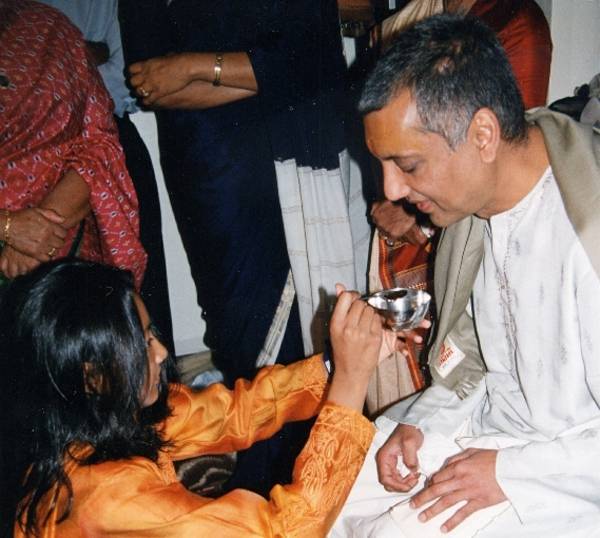
Breaking a fast
Image by Chandu Shah © Chandu Shah
Since the late 1970s Hastinapur has become another well-known place to travel to for Akṣaya-tṛtīyā. In 1987 about 5,000 pilgrims came for 269 tapasvīs while the next year 6,500 pilgrims performed the ceremony for 400 tapasvīs. One of the reasons is that traditionally it is the place where the original alms-giving event occurred.
In the 1970s, the Jain press started advertising the festival in Hastinapur and encouraged people to go there for the annual fast-breaking. However, Hastinapur had no temple dedicated to the first Jina, which was a disadvantage for devotees who wished to complete the fast in such a temple.
Hastinapur started to become a popular destination for Akṣaya-tṛtīyā in 1978, when a small temple at the back of the main Śvetāmbara temple, which is dedicated to Śāntinātha or Lord Śānti, was inaugurated as a temple to the First Lord. It contains detailed images of Ṛṣabhanātha or Lord Ṛṣabha and Śreyāṃsa, and thus depicts exactly the event the festival marks.
In 1985 to 1986 a temple especially dedicated to Ṛṣabha to commemorate his fast-breaking was built about two kilometres away from the city centre. It is called Pāraṇā-mandir or ‘Fast-breaking Temple’. Since then the routine of the festival at Hastinapur has included a chariot procession – ratha-yātrā – from one temple to the other.
In Hastinapur, the festival takes place over a whole week, requiring a great deal of preparation. Attendance at the sermons and the daily yātrā processions increases as the days go on.
On the day of Akṣaya-tṛtīyā, preparations for the fast-breaking ceremony start. Large quantities of sugar-cane are bought from local landowners and brought to the temple complex. The sugar-cane is crushed in the press owned by the temple and the juice poured into big earthenware pots.
The tapasvīs and their relatives start taking their seats on the cushions prepared for them in the ceremonial hall. Many are elegantly and richly dressed. The tapasvīs are garlanded with flowers. Bags of presents can be seen, which members of their family will offer to the temple to honour their own tapasvī.
A relative fetches sugar-cane juice in the small earthenware pot supplied by the temple administration. The tapasvīs are fed symbolically with a small amount by all their relatives present. The relatives rush to feed their heroic tapasvī, all wanting to touch the small vessel of juice at the same time. The tapasvīs are exhausted.
The next day tapasvīs start taking solid food again, in a special meal served in the temple eating-hall.
Reading
- ‘The Micro-Genre of Dāna-Stories in Jaina Literature: Problems of Interrelation and Diffusion’
Nalini Balbir - Indologica Taurinensia
edited by Nalini Balbir and Colette Caillat
volume 11
International Association of Sanskrit Studies; 1983
- ‘Past and Present of a Jain Festival’
Nalini Balbir - Jainism in a Global Perspective
edited by Sagarmal Jain and Shriprakash Pandey
Pārśvanātha Vidyāpīṭha; Varanasi, Uttar Pradesh, India; 1998
- Organizing Jainism in India and England
Marcus Banks - Oxford Studies in Social and Cultural Anthropology series; volume 3
Clarendon Press; Oxford, UK; 1992
- Śrī parvakathādi vividha viṣaya saṃgraha
Muni Bhuvanavijaya - Bhinmal, Rajasthan, India; 1980
- Jains in the World: Religious Values and Ideology in India
John E. Cort - Oxford University Press USA; New York, USA; 2001
- The Jains
Paul Dundas - Library of Religious Beliefs and Practices series; series editor John Hinnels and Ninian Smart; volume 14
Routledge Curzon Press; London, UK; 2002
- 'The Kalpa Sûtra of Bhadrabâhu'
Bhadrabāhu - translated and edited by Hermann Jacobi
Abhandlungen für die Kunde des Morgenlandes
Deutschen Morgenländischen Gesellschaft series; series editor Otto Loth; volume VII: 1
F. A. Brockhaus; Leipzig, Saxony, Germany; 1879
- ‘Festivals’
Jyoti Prasad Jain - Religion and Culture of the Jains
Jñānapīṭha Mūrtidevī granthamālā: English series; volume 6
Bhāratīya Jñānapītha; New Delhi, India; 1975
- Śrī Jainavrata-kathāsaṃgraha: 40 vrata-kathāoṃ kā saṃgraha
Dīpacandajī Varṇī - Surat, Gujarat, India; 1975
- Śrāddhavidhiprakaraṇa
Ratnaśekhara-sūri - Śreṣṭhi-Devacanda-Lālbhāī-Jaina Pustakoddhara Fund series; volume 106
Surat, Gujarat, India; 1960
- Historical Dictionary of Jainism
Kristi L. Wiley - Historical Dictionaries of Religions, Philosophies, and Movements series; series editor Jon Woronoff; volume 53
Scarecrow Press; Maryland, USA; 2004
Links
- Ṛṣabha, attendants and Jinas
-
This black stone figure of the first Jina, Ṛṣabhanātha or Lord Ṛṣabha, dates from the 12th century. The standing image is surrounded by the other 23 Jinas and his yakṣa and yakṣī – attendant deities.
The photograph can be enlarged and zoomed in to examine the piece in more detail. The photo and a short audio description are on the website of the auction house Christie's.
- Adinath procession at Shatrunjaya – part 1
-
This short YouTube video from 2011 captures part of a procession in the temple-city of Mount Shatrunjaya, in Gujarat. Chanting ‘Adinath’, the devotees are probably on their way to the main Adishvar temple, which is dedicated to Ṛṣabha. The first Jina, he is also known as Ādinātha or First Lord.
This is the first of four brief videos of the procession. You can watch the next part.
- Adinath procession at Shatrunjaya – part 2
-
This short YouTube video from 2011 captures a procession in the temple-city of Mount Shatrunjaya, in Gujarat. Chanting ‘Adinath’, the devotees are probably on their way to the main Adishvar temple, which is dedicated to Ṛṣabha. The first Jina, he is also known as Ādinātha or First Lord.
This is the second of four brief videos of the procession. You can watch the next part.
- Adinath procession at Shatrunjaya – part 3
-
This short YouTube video from 2011 captures part of a procession in the temple-city of Mount Shatrunjaya, in Gujarat. Chanting ‘Adinath’, the devotees are probably on their way to the main Adishvar temple, which is dedicated to Ṛṣabha. The first Jina, he is also known as Ādinātha or First Lord.
This is the third of four brief videos of the procession. You can watch the final part.
- Adinath procession at Shatrunjaya – part 4
-
This short YouTube video from 2011 captures part of a procession in the temple-city of Mount Shatrunjaya, in Gujarat. Chanting ‘Adinath’, the devotees are probably on their way to the main Adishvar temple, which is dedicated to Ṛṣabha. The first Jina, he is also known as Ādinātha or First Lord.
This is the last of four brief videos of the procession. You can watch the first part.
- Worship of R̥ṣabha
-
The Los Angeles County Museum of Art provides an illustrated manuscript page showing the worship of R̥ṣabhanātha or Lord R̥ṣabha, the first Jina, at Mount Shatrunjaya. Shatrunjaya is a major pilgrimage site in Gujarat, especially for Śvetāmbara Jains.
- Views of Shatrunjaya temples
-
Collection of photographs of the temple-city of Mount Shatrunjaya. The pre-eminent Śvetāmbara pilgrimage site, Shatrunjaya has nearly a thousand temples. The main temple is dedicated to Ṛṣabha, the first Jina, often called Ādinātha or First Lord. These photographs are presented by Professor Frances W. Pritchett of Columbia University in New York.
- +
- aAbhavya
- aAbhinandana
- aAbhiṣeka
- aĀcāra
- aĀcārāṅga-sūtra
- aĀcārya
- aAchalbhrata
- aAḍhāī-dvīpa
- aAdharma
- aAdho-loka
- aAdhyayana
- aAdvaita Vedānta
- aĀgama
- aAghātīya
- aAghātīya-karman
- aAgnibhuti
- aAgra
- aĀhāra
- aAhiṃsā
- aAhimsa Day
- aAjita
- aAjīva
- aAkampit
- aĀkāśa
- aAkbar the Great
- aAkṣaya-tṛtīyā
- aAlauddin Khalji
- aAlbert Einstein
- aAllah
- aAlms
- aĀlocanā
- aAloka-ākāśa
- aAmāri
- aAmbikā or Kūṣmāṇḍinī
- aAnagāra
- aAnanta
- aAnarthadaṇḍa
- aAnaśana
- aAnekānta-vāda
- aAṅga
- aAniconism
- aAnojjā
- aAntarāla
- aAntarāya-karma
- aAṇu
- aAṇu-vrata
- aAnukampā
- aAnuprekṣā
- aAnusvāra
- aApabhraṃśa
- aAparigraha
- aAra
- aĀrambha
- aĀrambhaja
- aĀratī
- aArdhamāgadhī Prākrit
- aArhaṃ
- aArhat
- aArśana-āvaraṇīya-karma
- aĀrta-dhyāna
- aĀryikā
- aĀryikā Jñānamati
- aĀśātanā
- aĀścarya
- aAscetic
- aAsceticism
- aAshram
- aAspiration
- aĀsrava
- aAṣṭa-maṅgala
- aAṣṭāpada
- aAstikāya
- aAstrolabe
- aAsura
- aAtheism
- aAticāra
- aAtiśayakṣetra
- aAtithisaṃvibhāgavrata
- aĀtma-vāda
- aĀtman
- aAuṃ
- aAurangzeb
- aAuspicious
- aAusterity
- aAvadhāna
- aAvadhi-jñāna
- aĀvaraṇī-yakarman
- aAvasarpiṇī
- aAvatāra
- aAvidyā
- aAxiom
- aĀyāga-paṭa
- aĀyambil
- aĀyu-karma
- aĀyurveda
- bBabur
- bBāhubali
- bBaladeva
- bBālāvabodha
- bBandha
- bBasadi
- bBazaar
- bBhadrankarvijay
- bBhagavant
- bBhaktāmara-stotra
- bBhakti
- bBhale
- bBharata
- bBhāṣā
- bBhāṣya
- bBhaṭṭāraka
- bBhāva
- bBhāva-pūjā
- bBhāvanā
- bBhavana-vāsin
- bBhavya
- bBhavyatva
- bBhaya
- bBhoga-bhūmi
- bBhogopabhoga
- bBodhi
- bBollywood
- bBrahmā
- bBrahma-deva
- bBrahmacārī
- bBrāhmaṇa
- bBraj Bhāṣā
- bBright fortnight
- bBritish Raj
- bBuddha
- bBuddhi-sagar
- bBuddhism
- bBuddhist
- cCaitya
- cCaityavāsin
- cCakravartin
- cCakreśvarī
- cCāmara
- cCandanā
- cCandragupta
- cCandraprabha
- cCanon
- cCāritra
- cCāritramohanīya-karman
- cCarũrī
- cCaste
- cCaturvidha-saṅgha
- cCaturviṃśati-stava
- cCāturyāma
- cCE
- cCelibacy
- cCha
- cChadmastha
- cChastity
- cCheda-sūtra
- cChristian
- cChristianity
- cClergy
- cCloning
- cColophon
- cCommentary
- cConch
- cConfession
- cCongregation
- cConsecration
- cCosmology
- cCremation
- cCrore
- cCult
- cCūrṇi
- dDādā-guru
- dDalit
- dDāna
- dDaṇḍa
- dDark fortnight
- dDarśana
- dDarśanamohanī-yakarman
- dDaśa-lakṣaṇa-parvan
- dDeity
- dDelhi Sultanate
- dDerāsar
- dDeśāvakāśika-vrata
- dDetachment
- dDevanāgarī
- dDevānandā
- dDevarddhi-gani
- dDevotee
- dDhamal
- dDhanuṣ
- dDhāra
- dDharma
- dDharma-dhyāna
- dDharma-sāgara
- dDharmastikaya
- dDhātakīkhaṇḍa
- dDholak
- dDhyāna
- dDiaspora
- dDig-vrata
- dDigambara
- dDīkṣā
- dDisciple
- dDīvālī
- dDivya-dhvani
- dDNA
- dDoctrine
- dDogma
- dDonor
- dDoṣa
- dDravya
- dDravya-pūjā
- dDrone
- dDuṣamā
- dDuṣamā-duṣamā
- dDuṣamā-suṣamā
- dDveṣa
- dDvīpa
- eEast India Company
- eEightfold Path
- eEkānta-vāda
- eEkendriya
- eElder
- eElders
- eEschatology
- eEtc up to
- fFarmān
- fFast
- fFatehpur Sikri
- fFestival
- fFestschrift
- fFiruz Shah
- fFly-Whisks
- fFolio
- fFour Noble Truths
- gGaccha
- gGaṇa
- gGaṇadhara
- gGanadharavada
- gGaṇeśa
- gGaṇin
- gGarba
- gGarbha
- gGarbha-gṛha
- gGaruḍa
- gGati
- gGene
- gGenomics
- gGhātī-yakarman
- gGhātīya
- gGhaznavid
- gGhiyasuddin Tughlaq
- gGhurid
- gGloss
- gGotra-karma
- gGujarāt
- gGujarati
- gGuṇa
- gGuṇa-sthāna
- gGuṇa-vrata
- gGupti
- gGuru
- gGuruṇī
- hHagiography
- hHajj
- hHaṃsa
- hHaribhadra
- hHariṇaigameṣin
- hHasta
- hHeresy
- hHiṃsā
- hHindi
- hHindu
- hHinduism
- hHīravijaya
- hHoroscope
- hHrīṃ
- hHumayun
- hHymn
- iIconoclasm
- iIconography
- iIdol
- iIndian Independence
- iIndology
- iIndra
- iIndrabhūti Gautama
- iIndriya
- iInitiation
- iIntercession
- iInvocation
- iIQ
- iIslam
- iIslamicate
- iIṣṭadevatā
- iĪśvara
- jJagat
- jJahangir
- jJain
- jJaina Devanāgarī
- jJaina Śaurasenī
- jJaina-dharma
- jJainaśāsana
- jJainness
- jJaisalmer
- jJamāli
- jJambū-dvīpa
- jJames Burgess
- jJanma
- jJanma-kalyāṇa
- jJarā
- jJāti
- jJina
- jJina-āgama
- jJina-bhavana
- jJina-bimba
- jJina-mātā
- jJinacandra-sūri
- jJinadatta
- jJinaprabha
- jJīva
- jJñāna
- jJñāna-āvaraṇīya-karma
- jJñāna-āvarṇiya
- jJñānsundar
- jJyotiṣka
- kKāla
- kKālakācārya-kathā
- kKālidāsa
- kKalpa-sūtra
- kKalpa-vṛkṣa
- kKalyāṇaka
- kKalyanvijay
- kKamaṇḍalu
- kKamaṭha
- kKarma
- kKarma-bhūmi
- kKarma-grantha
- kKarma-prakṛti
- kKarma-vāda
- kKarmon
- kKarnataka
- kKaṣāya
- kKathā
- kKāvya
- kKāya
- kKāyotsarga
- kKeśa-loca
- kKetu
- kKevala-jñāna
- kKevalin
- kKhalji
- kKharatara-gaccha
- kKnowledge
- kKriyā
- kKriyā-vāda
- kKṛṣṇa
- kKṣamā-śramaṇa
- kKṣapakaśreṇi
- kKṣatriya
- kKṣullaka
- kKulakara
- kKundakunda
- kKunthu
- lLabdhi
- lLaity
- lLakh
- lLāñchana
- lLands of Action
- lLaukāntika
- lLavaṇa-samudra
- lLeśyā
- lLiṅga
- lLinguistics
- lLoka
- lLoka-ākāśa
- lLoka-puruṣa
- lLoka-vāda
- lLotus
- lLotus lake
- mMadhya-loka
- mMahā-videha
- mMahā-vrata
- mMahābhārata
- mMahāmastakābhiṣeka
- mMāhārāṣṭra
- mMāhārāṣṭrī Prākrit
- mMahattarā Yākinī
- mMahāvīr Jayantī
- mMahāvīra
- mMakāra
- mMakkhali Gośāla
- mMalli
- mMāna-stambha
- mManaḥ-paryāya-jñāna
- mMaṇḍala
- mMaṇḍapa
- mMandit
- mMaṅgala
- mMantra
- mMantras
- mManuṣya-loka
- mMarāṭhī
- mMārgaṇā
- mMartyr
- mMarudevī
- mMaṭha
- mMati-jñāna
- mMauryaputra
- mMecca
- mMendicant lineage
- mMetarya
- mMiracle
- mMithyādṛṣṭi
- mMohandas Gandhi
- mMohanīya-karma
- mMokṣa
- mMonastic order
- mMonasticism
- mMonk
- mMonotheism
- mMosque
- mMount Meru
- mMount Sammeta
- mMṛgāvatī
- mMughal
- mMuhammad
- mMuhammad bin Tughlaq
- mMuhpattī
- mMūla-sūtra
- mMūlaguṇa
- mMumbaī
- mMuni
- mMunisuvrata
- mMurad Bakhsh
- mMūrti-pūjaka
- mMuslim
- mMysticism
- nNābhi
- nNāga-kal
- nNāgapurīya Tapā-gaccha
- nNāgarī
- nNāma-karma
- nNamaskāra-mantra
- nNami
- nNandīśvara-dvīpa
- nNandivardhana
- nNandyāvarta
- nNāraka
- nNāraki
- nNasalisation
- nNātha
- nNavrātrī
- nNaya-vāda
- nNemi
- nNidāna
- nniggaṃthāṇa vā 2
- nniggaṃtho vā 2
- nNigoda
- nNihnava
- nNikṣepa
- nNirgrantha
- nNirjarā
- nNirvāṇa
- nNiryukti
- nNiṣidhi
- nNitya
- nNiyati
- nNo-kaṣāya
- nNudity
- nNun
- oOcean of milk
- oOmniscience
- oOrdination
- ppa°
- pPadmaprabha
- pPadmāsana
- pPadmāvatī
- pPādukā
- pPalanquin
- pPalette
- pPañca-muṣṭi
- pPāṇḍava
- pPaṇḍit
- pPandit Dalsukh D. Malvania
- pPandit Sukhlalji
- pPāṇipātra
- pPāpa
- pParamātman
- pParameṣṭhin
- pPāraṇā
- pParigraha
- pPariṇāma
- pParīṣaha
- pParokṣa
- pPārśva
- pPārśvanātha
- pParyāya
- pParyuṣaṇ
- pPaṭa
- pPatan
- pPātra
- pPenance
- pPersian
- pPhala
- pPhilology
- pPicchikā
- pPilgrimage
- pPīr
- pPolymath
- pPoṣadha
- pPossession
- pPothī
- pPrabhas
- pPradakṣiṇā
- pPradeśa
- pPrākāra
- pPrakīrṇaka-sūtra
- pPrākrit
- pPramāda
- pPramukhā
- pPrati-vāsudeva
- pPratikramaṇa
- pPratimā
- pPratiṣṭhā
- pPratyākhyāna
- pPratyakṣa
- pPravacana
- pPrāyaścitta
- pPrayer
- pPre-modern
- pPreach
- pPredestination
- pProtestant
- pProvenance
- pPudgala
- pPūjā
- pPujārī
- pPukharavara-dvīpa
- pPuṇya
- pPūrva
- pPuṣkara-dvīpa
- pPuṣpadanta
- pPyre
- qQur’an
- rRāga
- rRāhu
- rRainy season
- rRajasthan
- rRajasthani
- rRājimatī
- rRajoharaṇa
- rRajput
- rRāma
- rRāmāyaṇa
- rRangoli
- rRās-garbā
- rRasa
- rRathanemi
- rRatna-traya
- rRātri-bhojana
- rRaudra-dhyāna
- rRecto
- rRelic
- rRenunciation
- rRetroflex
- rRevatī
- %Ṛg-veda
- rRite
- rRosary
- %Ṛṣabha
- %Ṛṣabhanātha
- rRupee
- sSaciyā Mātā
- sSādhu
- sSādhvī
- sSāgāra
- sSaint
- sŚaivaism
- sŚaka-saṃvat
- sSallekhanā
- sŚalya
- sSamacatuṣṭha
- sSamādhimaraṇa
- sSamaṇi
- sSāmarambha
- sSamavasaraṇa
- sSāmāyika
- sSaṃbhava
- sSamiti
- sSaṃjñā
- sSaṃkalpaja
- sSaṃsāra
- sSamudghāta
- sSaṃvara
- sSaṃvega
- sSamyak-cāritra
- sSamyak-darśana
- sSamyak-jñāna
- sSamyaktva
- sSaṃyama
- sSanctuary
- sSandalwood
- sSaṇgha
- sSanskrit
- sSant
- sŚānti
- sSapta-bhaṅgi-naya
- sSārambha
- sSarasvatī
- sSarvajña
- sSāsan-devi
- sŚāsana-devatā
- sŚāstra
- %Ṣaṭ-jīvanikāya
- sSatī
- sSatīmātā
- sSatya
- sSchism
- sScribe
- sScripture
- sSect
- sSecularism
- sŚenāī
- sSermon
- sŚeṣavatī
- sSevā
- sSeven fields of donation
- sShah Jahan
- sShantidas Jhaveri
- sShrine
- sSiddha
- sSiddha-śilā
- sSiddhacakra or Navadevatā
- sSiddhānta
- sSiddhārtha
- sSiddhi
- sSikh
- sSikhism
- sŚikṣā-vrata
- sŚīla
- sSin
- sSindh
- sŚītala
- sŚiva
- sSkandha
- sSomanatha
- sŚraddhā
- sŚramaṇa
- sŚrāvaka
- sŚrāvakācāra
- sŚrāvikā
- sŚreyāṃsa
- sŚrī
- sŚrīvatsa
- sŚruta-jñāna
- sŚruta-pañcamī
- sSthānaka-vāsin
- sSthāpanācārya
- sSthāvara
- sSthavira
- sSthiti
- sStrīmukti
- sStūpa
- sSubcontinent
- sSudarshana
- sŚuddhi
- sSudharma
- sŚūdra
- sSufism
- sSukha
- sŚukla-dhyāna
- sSulasā
- sSultan
- sSumati
- sSundarśrī
- sSupārśva
- sSūri
- sSuṣamā
- sSuṣamā-duṣamā
- sSuṣamā-suṣamā
- sSūtra
- sSuyam me ausam! Tenam bhagavaya evamakkhayam
- sSvādhyāya
- sSvāhā
- sSvastika
- sŚvetāmbara
- sŚvetāmbara Terāpanthin
- sŚvetāmbaras
- sSwan
- sSyād-vāda
- tTabla
- tTantra
- tTapā-gaccha
- tTapas
- tTāraṇ Svāmī Panth
- tTattva
- tTattvārtha-sūtra
- tTemple
- tTemple-city
- tThe Enlightenment
- tTheology
- tThree worlds
- %Ṭīkā
- tTilaka
- tTīrtha
- tTīrthaṃkaranāma-karman
- tTīrthankara
- tTransliteration
- tTrasa
- tTrasa-nāḍī
- tTriśalā
- tTriṣaṣṭi-śalākā-puruṣa-caritra
- tTti bemi
- tTughlaq
- tTunk
- uUdumbara
- uUniversal History
- uUpādhyāya
- uUpāṅga
- uUpaniṣads
- uUpāsaka
- uUpasarga
- uUpāśraya
- uŪrdhva-loka
- uUtsarpiṇī
- uUttarādhyayana-sūtra
- vVāhana
- vVaimānika
- vVairāgya
- vVaiṣṇava
- vVaiśramaṇa
- vVaiśya
- vValabhī
- vVanaspatikāya
- vVandana
- vVaṇik
- vVarṇa
- vVāsudeva
- vVāsupūjya
- vVayubhūti
- vVeda
- vVedanīya-karma
- vVegetarianism
- vVehicle
- vVernacular
- vVerso
- vVidyā
- vVidyā-devī
- vVihāra
- vVijñapti-patra
- vVikrama-saṃvat
- vVikṛti
- vVimala
- vVinaya
- vVipāka
- vVirji Vora
- vVirodhaja
- vVīrya
- vVisarga
- vViṣṇu
- vVītarāga
- vVizier
- vVotive
- vVow
- vVrata
- vVS
- vVyakta
- vVyantara
- vVyasana
- yYakṣa
- yYakṣī
- yYantra
- yYaśoda
- yYaśovijaya
- yYati
- yYātrā
- yYoga
- yYoginī
- yYojana


